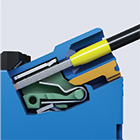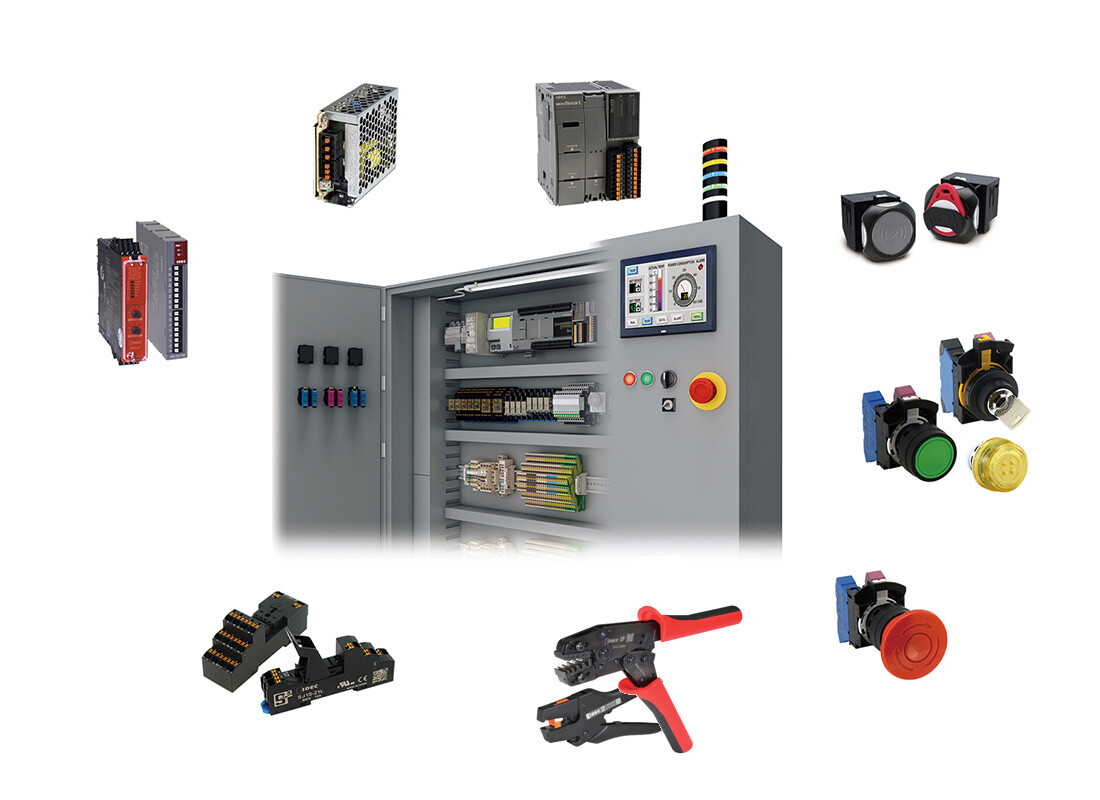
Man-hour reduction
Easy wiring by Push-in insertion of wires to terminals. This reduces wiring work time by 55% compared to screw type terminals. With Push-In terminals work more efficiently and more productively.
Space saving
Since the width of the terminal and the pitch between ducts are short, it saves space compared to the screw type terminal block. As a result, the control panel can be downsized.
Vibration resistance
The push-in terminals provide high strength and vibration resistance. The wire connection will not loosen due to vibration like screw terminals. No need to torque terminals after transportation or installation.
Comparison of screw type and push-in type switch wiring work

[Conditions]
Push-in: Insert the ferrule terminal wire
Screw: Insert the wire and tighten the screw with an electric
screwdriver.
PRODUCT FEATURE
Reduces length of process
.png?width=800&height=202&name=MicrosoftTeams-image%20(3).png)
PRODUCT FEATURES
Simulation of man-hour reduction
KEY FEATURES
High Visibility
The terminal number on the socket can be clearly seen on the socket preventing incorrect wiring.


KEY FEATURES
Reduce maintenance work
KEY FEATURES
IDEC Push-In Structure
Structure that increases the wire holding force as it is pulled
P0 = Initial spring force
P1 = Wire tensile force
P2 = Spring force (wire holding force) increases by pulling the wire


TECHNICAL ARTICLE
Push-In Solutions
Please download the technical article to learn more about our Push-In Solutions.

SOLUTIONS
Customers involved in production sites
With the reliable reliability of Push-in products, we propose a method for stable operation of production equipment at the production site.

SOLUTIONS
Equipment manufacturer customers
We propose ways to reduce man-hours in all situations, from equipment assembly to installation and maintenance.
SOLUTIONS
IDEC OFFERS A WIDE RANGE OF PUSH-INTERMINAL PRODUCTS FOR CONTROL PANELS.
Frequently Asked Questions
Is it possible to connect a single wire to the Push-In terminal block?
Yes. It is possible.
Ideal for single wire connections that are often used for building installations. If the conductor is rigid enough, it can be connected by simply inserting it by hand without using a tool. Check the applicable wire cross-sectional area of "single wire" described in the catalog.
Is it possible to connect the stranded wire to the Push-In terminal block as it is?
Is there a recommendation for a ferrule crimping shape suitable for the Push-In terminal block?
Basically, there are no restrictions on the crimping shape. There is no problem if the conductor is compressed safely and in a highly airtight manner.
How do I remove the conductor from the Push-In terminal block?
What are the benefits of pushers?
Which is the connection point for the tester?
Is it okay to push the pusher with a Phillips screwdriver?
What are the DIN Rails that can be used for the ground terminal block?
What are the benefits of using sensor/actuator terminal blocks?
In the conventional screw type terminal block, one terminal block is required for each of "power supply (2 poles)", "earth (1 pole)", and "signal (1 or 2 poles)", but this product requires them. Since it can be connected with one terminal block, it contributes to space saving.
Fuse terminal block - What is the usage of terminal block with LED?
When the fuse blows, the LED lights up and it can be used for overcurrent detection.
Are there any precautions to take when cutting the short care (crossover metal fittings)?
Since the cut surface that was cut off becomes the charging part, the charging part may be exposed on the surface, such as the insulating plastic being chipped unless the tool can cut sharply, so a dedicated short bar (crossover metal fitting) cutter (model number) : KT14 / Order model number: 1157820000) is recommended. Be sure to use it so that the separated cross section faces the inner surface side of the terminal block. In addition, it is prohibited to separate the two poles.
Is there a maximum current value (current rated value) for the short bar (crossover bracket)?
It is designed to allow the maximum current of the compatible terminal block to flow, and the current rating is set. When the currents of multiple poles are aggregated, it is necessary to design the circuit so that the maximum current value does not exceed the allowable current (value described in the catalog).
Is there a ferrule for two wires?
We also offer ferrules that can connect two wires.

REACH OUT TO US TODAY
©2025 IDEC Corporation. All rights reserved. Privacy Policy





